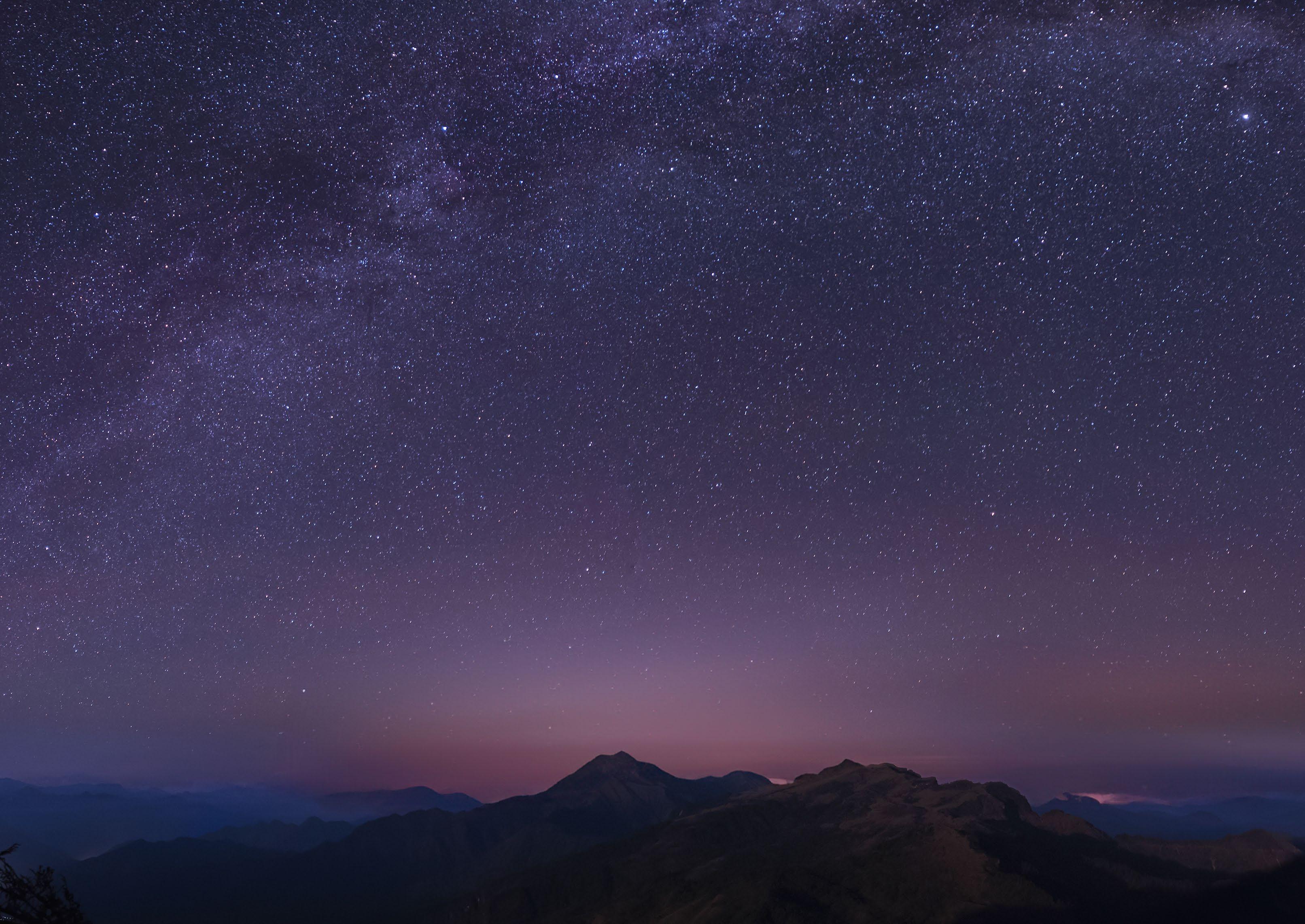IAU Centre for the Protection of the Dark and Quiet Sky from Satellite Constellation Interference


IAU Centre for the Protection of the Dark and Quiet Sky from Satellite Constellation Interference

“Protecting the sky is the core mission of the IAU because without the sky, there is no science of astronomy.”
Prof. Willy Benz, IAU President Elect

Throughout human history, we have looked to the night sky with longing and curiosity. Now, as well as the stars, we can also see the trails of satellites in orbit around our world. In this long-exposure photo not only can we see the constellations of Orion and Taurus, and the Milky Way but we can also see the trails left by numerous satellites crossing the sky. These include the International Space Station, satellites from the Starlink mega-constellation, and myriad other satellite and rocket bodies. These sunlit trails were captured in separate long exposures during a period of about two hours before dawn sky and then digitally combined into a single image. Credit: Max Alexander, Our Fragile Space exhibition



The International Astronomical Union’s Centre for the Protection of the Dark and Quiet Sky from Satellite Constellation Interference, or IAU CPS, was born out of widespread concern in the astronomical community and beyond about the growing impact of satellite constellations on one of our most precious natural resources: the sky. It brings together astronomers, satellite operators and manufacturers, policy experts and the wider community with the intention to protect the science of astronomy and access to a dark and quiet sky from the impact of satellite constellations.
In recent years, the cost of access to space has been reduced significantly, opening the doors for full commercial utilisation. Commercial satellite companies and governments have endeavoured to launch large-scale space missions with the aim of supplying individual, commercial and government customers worldwide with broadband internet, Earth-observation data, and other applications. The potential benefits of satellite constellations to humanity are great, but there are associated concerns of astronomers about unintended negative consequences. Creative solutions and technological innovation are needed to confront and solve these problems.
opinions, findings, and conclusions or recommendations expressed in this material are those of the author(s) and do not necessarily reflect the views of the National Science Foundation. C.O.C., H.H.H. and C.A.T. also acknowledge support from the NASA Solar System Observations program (grant 80NSSC19K0869)
This graph shows the exponential growth in the number of active satellites since the beginning of the Space Age. As of June 19, 2024, there were 9,953 active satellites in orbit.
Source and Credit: Jonathan McDowell
Astronomers became acutely aware of the impact of satellite constellations with the launch of the first 60 Starlink satellites in May 2019. In as little as five years, a few companies have launched close to 7,000 constellation satellites into orbit around our planet — almost as many as the number of individual satellites that have been launched since the dawn of the Space Age some 65 years ago. This proliferation of satellite constellations in low Earth orbit (LEO) poses significant risks for those who value dark and quiet skies. These satellites may reflect sunlight onto optical telescopes, altering the night sky’s appearance, and emit electromagnetic radiation from radio to infrared that may cause harmful interference with astronomical observations. Both ground-based and space-based telescopes in LEO are affected. No place on Earth is free from the effects of these global satellite constellations, and regulatory filings indicate there may be many more satellites launched by both companies and governments in coming years.
Recognising the astronomical community’s deep concern, the U.S. National Science Foundationfunded NOIRLab, the Association of Universities for Research in Astronomy (AURA), and the American Astronomical Society (AAS) organised the Satellite Constellations 1 (SATCON1) workshop in June and July 2020, attended by participants from around the world. This workshop aimed to quantify the impact of LEO satellite constellations on optical wavelengths and explore possible mitigations, and was attended by over 250 astronomers and representatives from constellation operators.
In October, 2020, the UN Office of Outer Space Affairs (UNOOSA), the Government of Spain and the IAU sponsored the Workshop on Dark and Quiet Skies for Science and Society (D&QS1). Building on the SATCON1 findings, the result was an extensive report on impacts of satellite constellations and ground-based light pollution as well as an international policy analysis.
552,267
Total number of planned satellites in large constellations according to US FCC and ITU license applications as of June 2024.
The following year, in July, SATCON2 was held to develop specific, implementable paths for carrying out these recommendations, and address the risks posed by LEO satellites across all wavelengths, not just optical. The workshop concluded that establishing a dedicated centre of expertise under the auspices of the IAU would likely be an effective avenue for implementing the recommendations.
In October 2021, UNOOSA, the Government of Spain and the IAU hosted D&QS2, focused on the definition and implementation of technical mitigation needs and the elements of a regulatory framework. The conclusions reached at SATCON2 and D&QS2 led the IAU to call for the establishment of the CPS.
In February 2022, two co-hosts were selected for this initiative: NSF NOIRLab, the U.S. centre for ground-based optical astronomy, and the SKA Observatory (SKAO), an intergovernmental organisation headquartered in the UK with member states on five continents that is leading the construction of some of the largest radio telescopes ever in South Africa and Australia.
The CPS governance structure was established and the same year, the centre held several listening sessions with the astronomy community to incorporate their ideas into the work plan of the centre. Thanks to the institutional support of the IAU and the co-hosts, an international network of volunteers was organised with volunteer leadership for four specific focus areas.
The early work of the CPS was highlighted in an IAU symposium in October 2023 that brought together face-to-face representatives from the astronomy community, policy makers, diplomats, as well as representatives of industry. This symposium provided a dedicated space where these communities could share their current work regarding large satellite constellations and their impact on astronomy and the night sky. The meeting also provided the opportunity to receive broad input on the centre’s position paper, which set out publicly for the first time its recommendations (see p29). The meeting also provided the backdrop for the launch of the Group of Friends of the Dark and Quiet Sky for Science and Society, an initiative launched by the Delegations of Chile and Spain on the United Nations Committee on the Peaceful Uses of Outer Space (UN COPUOS).

The IAU symposium Astronomy and Satellite Constellations: Pathways Forward brought together close to 250 attendees from more than 40 countries in La Palma, Spain and online in October 2023. Among them were representatives from industry, government, academia and astronomical observatories. The event provided an opportunity
to discuss mitigation efforts and opportunities, and featured over 60 talks and panel discussions with experts sharing their work on detailed technical studies, policy advances, industry relations and community engagement.
All talks are available online
The impact of satellite constellations on optical and infrared astronomy and the night sky is heavily influenced by the brightness of their constituent satellites, which varies based on spacecraft design, operational attitude, altitude, orbital position, and wavelength. Satellite constellations also impact radio astronomy through the strong data downlinks they need and their unintentional emissions at radio frequencies. The rapidly-increasing number of satellites in orbit also has a wider societal impact, impacting communities and traditions in complex ways.
Most satellites in LEO are constructed from materials that reflect sunlight, making them visible to the unaided eye, when not in Earth’s shadow. Depending on the satellite’s altitude, orientation, surface characteristics, and the darkness of the viewing site, these reflections may be observed throughout the entire night. That said, the vast majority of LEO satellites are visible to major observatories when close to the horizon at twilight. In some cases (e.g. BlueWalker3), the larger satellites designed to communicate directly with cellular phones have been found to be among the brightest objects in the night sky. Efforts by the industry to identify and develop novel approaches to spacecraft design and mechanisms to reduce the brightness of satellite systems are ongoing.
Beyond specific satellites and constellations, the combined effect of current satellites in orbit and the accumulation of space debris may already be causing up to a 10% increase in the brightness of the night sky compared to natural levels2. The 10% value exceeds the classification threshold established by the IAU in 1979, which should not be surpassed at large astronomical observatory sites.
With the increase of satellite streaks on optical images and the possible increase in the brightness of the night sky background the effective sensitivity of optical and infrared astronomical telescopes on Earth may have already decreased due to the unprecedentedly high activity in LEO. Unmitigated LEO satellite systems, with a steadily increasing density in the sky, pose a significant threat to optical and infrared astronomy, which is a fundamental driver of science and technology.
16.5 is the upper limit of apparent magnitude visible to the typical human eye.
2M Kocifaj, F Kundracik, J C Barentine, S Bará, The proliferation of space objects is a rapidly increasing source of artificial night sky brightness, Monthly Notices of the Royal Astronomical Society: Letters, Volume 504, Issue 1, June 2021, Pages L40–L44, https://doi.org/10.1093/mnrasl/slab030
However, this technology is in its early stages of development and testing to evaluate it’s performance, and not all satellite operators have implemented it. Consequently, many systems already deployed adversely affect optical and infrared astronomical observations by reflecting sunlight and leaving bright streaks on astronomical images. In reality, all sunlight streaks adversely affect observations. Depending on the brightness, such interference has the potential to invalidate entire datasets. Getting the brightness of those streaks below magnitude 71 will reduce the impact, and in the extreme case, save about 10 times the area lost to streaks.
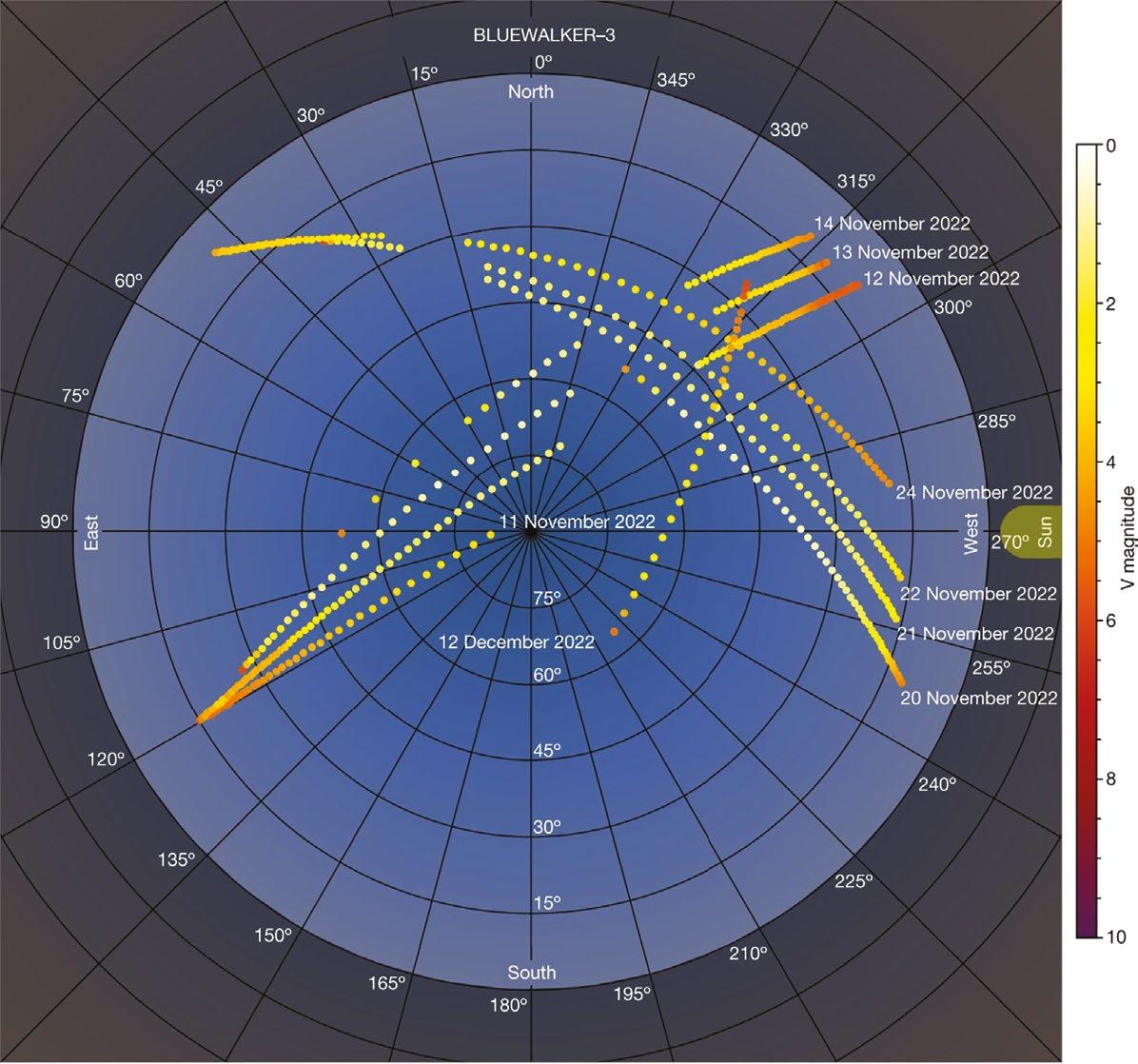
Apparent brightness of the BlueWalker3 satellite after unfolding over multiple passes. This plot shows the correlation of apparent brightness with the on-sky position of the satellite relative to the Sun, becoming in some cases one of the brightest objects in the sky.
Starlink satellites on the way to parking orbit.
Around 19 Starlink satellites were imaged shortly after launch in November 2019 by DECam on the Víctor M. Blanco 4-meter Telescope at the Cerro Tololo Inter-American Observatory (CTIO) by astronomers Clara Martínez-Vázquez and Cliff Johnson. The gaps in the satellite tracks are due to the gaps between the DECam CCD chips.
Credit: CTIO/NOIRLab/NSF/AURA/ DECam DELVE Survey

In the lower part of the electromagnetic spectrum, radio telescopes face a significant challenge arising from the active radio transmissions from satellites, their unnecessary leakage of radiation from onboard electronics, and even the reflection of far-away terrestrial transmitters on satellites.
Any transmitting satellite visible to a radio observatory can cause a signal that disrupts radio observations, even at frequencies other than the satellite’s nominal carrier frequencies. The strength of the detected signal depends on the pointing orientation of both the satellite and the radio telescope. As satellites move across the sky, their emissions can be received through the main beam or sidelobes of a radio telescope, amplifying them significantly compared to terrestrial transmitters, which are usually located at or behind the horizon. Even in the most remote observing sites, far from terrestrial transmitters, satellites high in the sky can still be a potential source of harmful interference, as the image by Jeff Warner at the end of this brochure shows.
In extreme cases, spaceborne Earth or weather exploration radars can damage radio astronomical receiver systems. Additionally, satellite emissions can mimic or interfere with observations of transient astronomical radio sources.
Radio astronomy requires the use of a wide range of frequencies, including outside of those allocated to the radio astronomy service, to enable observations of specific phenomena and improve sensitivity.
While these passive observations do not produce interference to other users of the radio spectrum, they can be affected by transmissions from other services rightfully using their allocated radio bands. There are no international protections for radio astronomy observations outside of radio astronomy bands. National or regional protection zones, as well as geographical separation and natural shielding against terrestrial anthropogenic radio emissions, provide some protection.
However, these national protections do not extend to space, and therefore large satellite constellations pose a significant challenge to the traditional operation of radio observatories. Until recently, there were no protections for radio observatories from satellite transmissions, now countries are starting to impose conditions for satellite licences (market access or launching) which include coordination with radio observatories to implement mitigation measures.
Radio images taken with the QUIJOTE telescopes from the Teide Observatory, Tenerife, between 10GHz and 14GHz. The image on the left taken in 2014 shows the bright band of geostationary satellites at 35,000km altitude. The image on the right taken in 2024 shows additional interference across the sky (small red dots) caused by Starlink satellites. Credit: QUIJOTE collaboration.
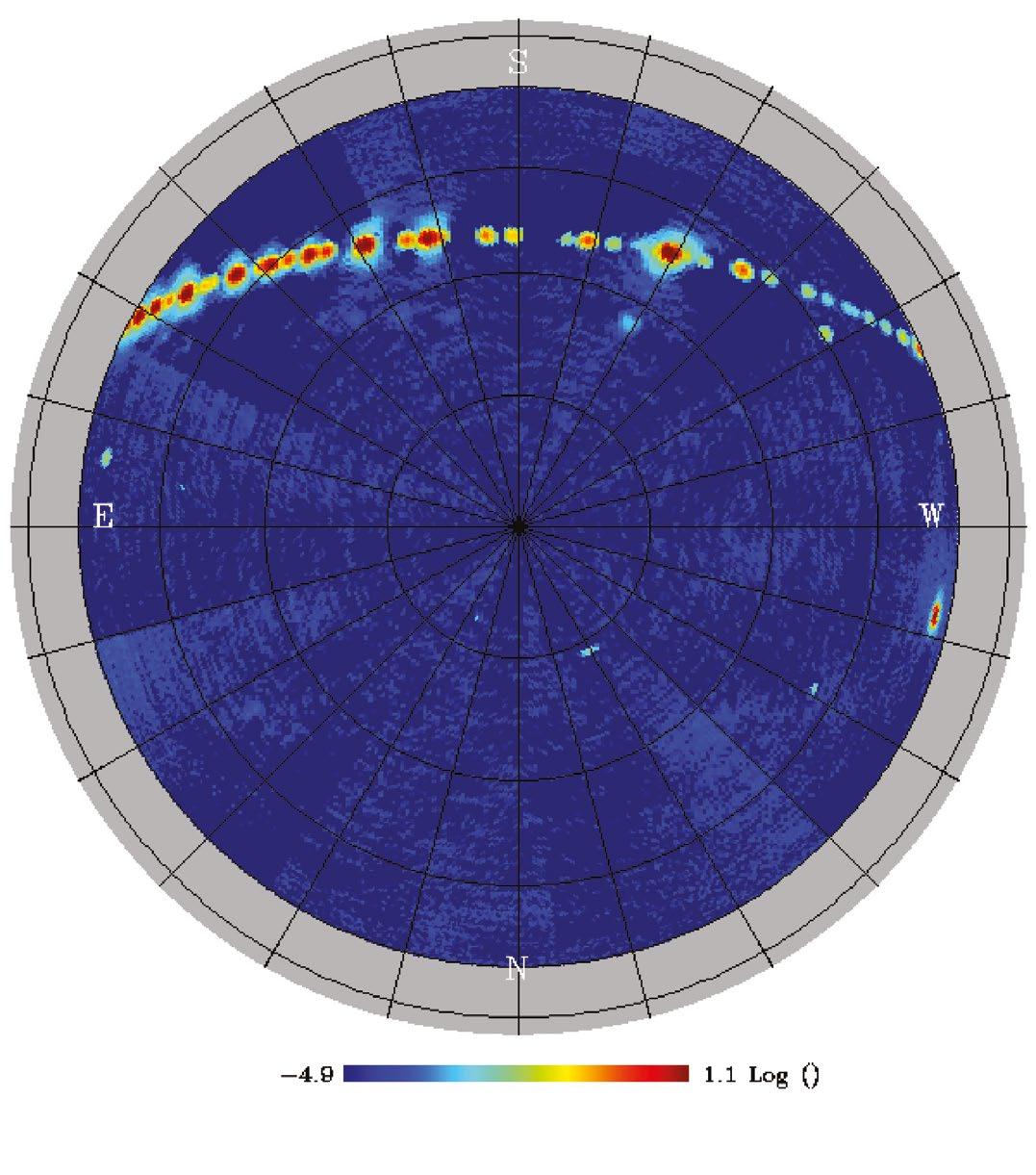
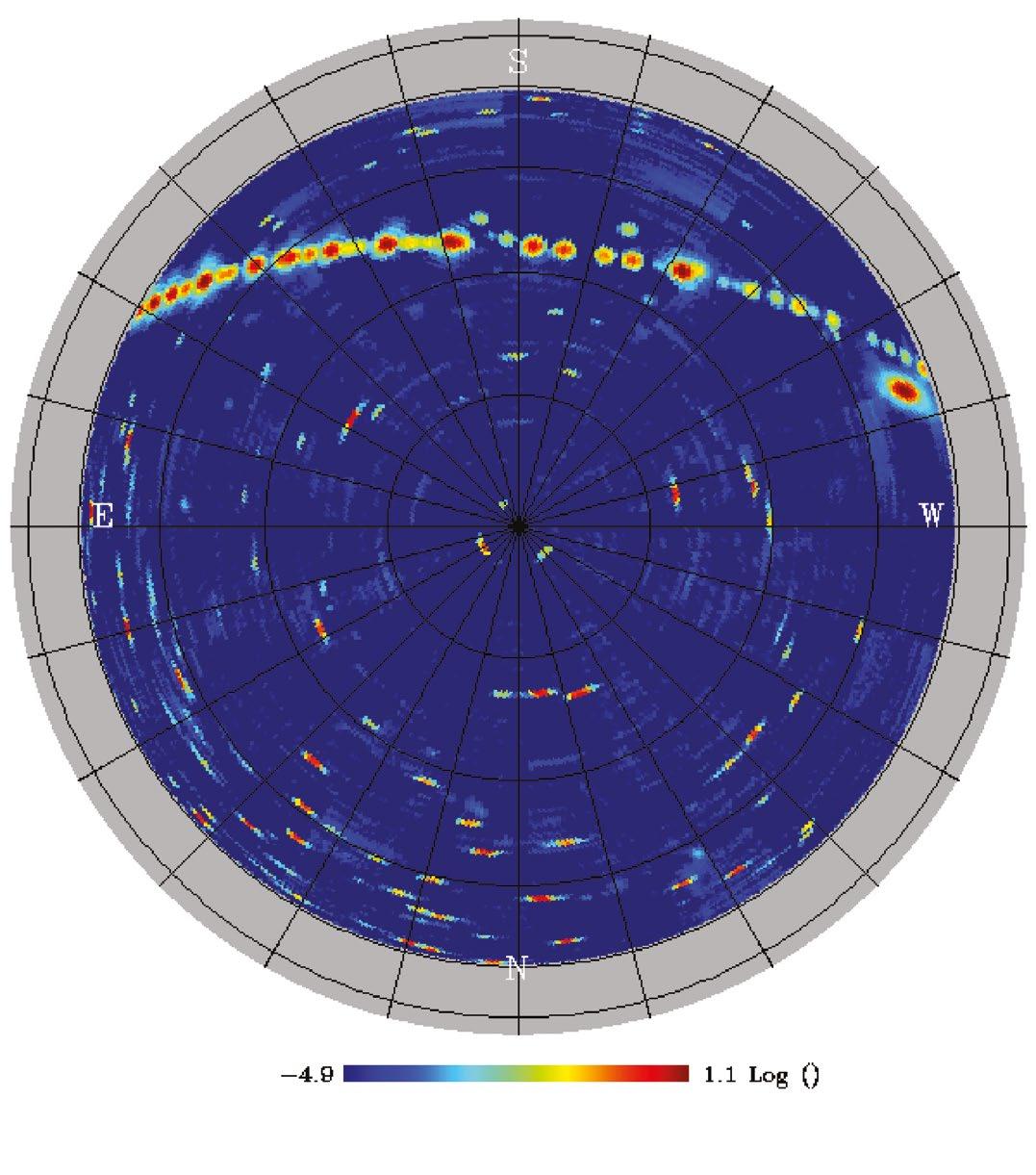

It is not only professional astronomers who stand to be affected by changes to the night sky brought about by the effects of large numbers of satellite constellations. Humanity has looked to the stars for millennia, finding their beginnings, stories, and symbols in the night sky. The stars have served as a map, clock, and calendar, providing social structure and cultural touchstones. Many Indigenous communities have long-standing traditions that involve the night sky. In addition, there are many others across the globe for whom viewing starry night skies is of personal, cultural, and religious or spiritual relevance. Continued access to dark, starry night skies has been and continues to be of great importance to many around the world.
The ongoing utilisation of low Earth orbit and the development of satellite constellations can be used as means to provide internet and other services to a variety of communities who currently lack access to such means of connectivity. However, the appearance of large numbers of satellites in the heavens above can also negatively impact the transmission of cultural traditions and teachings tied to the stars. Furthermore, there are many who argue that the human appropriation of space in this way is objectionable and is yet another way in which the conquer/colonising mindset, which has brought about much harm to many communities and to the Earth itself, is being made manifest — this time, to include the skies above and the space beyond. It is important to be mindful of such painful histories and avoid repeating the colonial mistakes of the past as our level of engagement with the space environment continues to grow.
As a centre of the IAU, the CPS supports the 2007 La Palma Declaration in Defence of the Night Sky and the Right to Starlight, and in particular its principles that:
“An unpolluted night sky that allows the enjoyment and contemplation of the firmament should be considered an inalienable right of humankind equivalent to all other environmental, social, and cultural rights, due to its impact on the development of all peoples and on the conservation of biodiversity. The progressive degradation of the night sky must be considered an imminent risk that must be faced, in the same fashion that the main problems concerning resources and the environment are addressed.”
This perspective requires regulatory bodies to view space as a common resource that must be protected for all.
The Centre brings together astronomers, satellite operators, regulators and the wider community and acts as a bridge between all stakeholders to protect the dark and quiet skies. It builds on the vast amount of work carried out by our two host institutions and more generally the astronomy community, recognising the various interests of different stakeholders according to wavelength, existing regulations, and expected impact.
Our vision is to become the leading voice for astronomical matters that relate to the protection of the dark and quiet sky from satellite constellations and to act as a hub of information and resources to which any stakeholder group will be able to contribute and from which they can draw in support of their own activities.
Our mission is to coordinate efforts and unify voices across the global astronomical community with regard to the protection of the dark and quiet sky from satellite constellation interference.
IAU Centre for the Protection of the Dark and Quiet Sky from Satellite Constellation Interference (IAU CPS) org chart
The CPS is co-hosted by the US national optical observatory, NSF NOIRLab, headquartered in Tucson, Arizona, USA, and by the SKAO, the international radio astronomy observatory headquartered at Jodrell Bank in the UK, under the sponsorship of the International Astronomical Union.
The CPS Management Team consists of a director, assisted by two co-directors, one from NOIRLab and one from the SKAO, representing optical and radio astronomy respectively.
The work of the CPS is supervised by a Steering Committee composed of the directors of NOIRLab and of the SKAO, the IAU assistant general secretary, and one more member selected by each organisation, to add up a total of six members.
External advice to the Management Team is provided by a science and technology Advisory Committee, made up of 10 representatives from the astronomical community plus other stakeholders with a range of different interests.
Based on community recommendations, the activities of the CPS have been organised into four specialised areas or “hubs”: the Satellite Hub, the Policy Hub, the Industry and Technology Hub, and the Community Engagement Hub.
This hub structure is essential to the CPS’s effectiveness. Protecting dark and quiet skies requires collaboration from diverse groups and the integration of a wide range of expertise. The hubs serve as a unifying framework, bringing together individuals and organisations,
and enabling contributions from groups with specialised knowledge. While some knowledge may be specific to one hub, it can play a crucial role in another. This model ensures that expertise and efforts are directed where they are most needed.









Two years after its launch, the CPS counts around 350 individual members contributing to and supporting its work. Those members are distributed across four hubs working on different topics and come from close to 50 countries around the world.
Institutions from 18 countries have expressed support for the work of the centre and in some cases also committed resources to contribute to its work. They include several national societies and research organisations as well as universities, international bodies, and intergovernmental organisations.


The CPS welcomes other organisations wanting to publicly express their support for its work. Interested organisations can contact the CPS Management team. Membership is free.
SatHub is the community-driven worldwide branch of the CPS that works on the collection and analysis of artificial satellite observations. The hub’s primary focus is to centralise the development of tools for predicting satellite brightness and location, and to validate these predictions through empirical observation.
SatHub is the largest of the hubs and has over 200 members.
The hub has also strengthened its connections with key players in space situational awareness (SSA) and satellite operations, including Privateer, The Exclosure, Slingshot Aerospace, European Centre for Space Safety, The Aerospace Corporation, AST SpaceMobile, SpaceX, Amazon Kuiper, Planet Labs, and more. SSA is a critical issue for SatHub because an increasing number of satellites in LEO makes it more challenging to schedule observations without satellite interference present.
SatHub has structured its efforts into the following key areas:
• Provide open source software to the community to facilitate intentional observations and/or avoidance of commercial LEO satellites at all wavelengths;
• Collect and analyse observations of commercial LEO satellites to determine impacts on specific science investigations, provide feedback to operators and other industry partners, and disseminate the current state of the sky to the astronomical community and general public; and
• Serve as a “one-stop shop” for observers and stakeholders worldwide to work together to publish our findings and provide sciencebased expert recommendations.
SatHub’s current focus is on the development of software for the community to facilitate observations and the avoidance of bright commercial LEO satellites. The hub aims to use its observations to quantify science impacts and inform policies, and welcomes participation from the professional and amateur astronomy community in all areas described above.
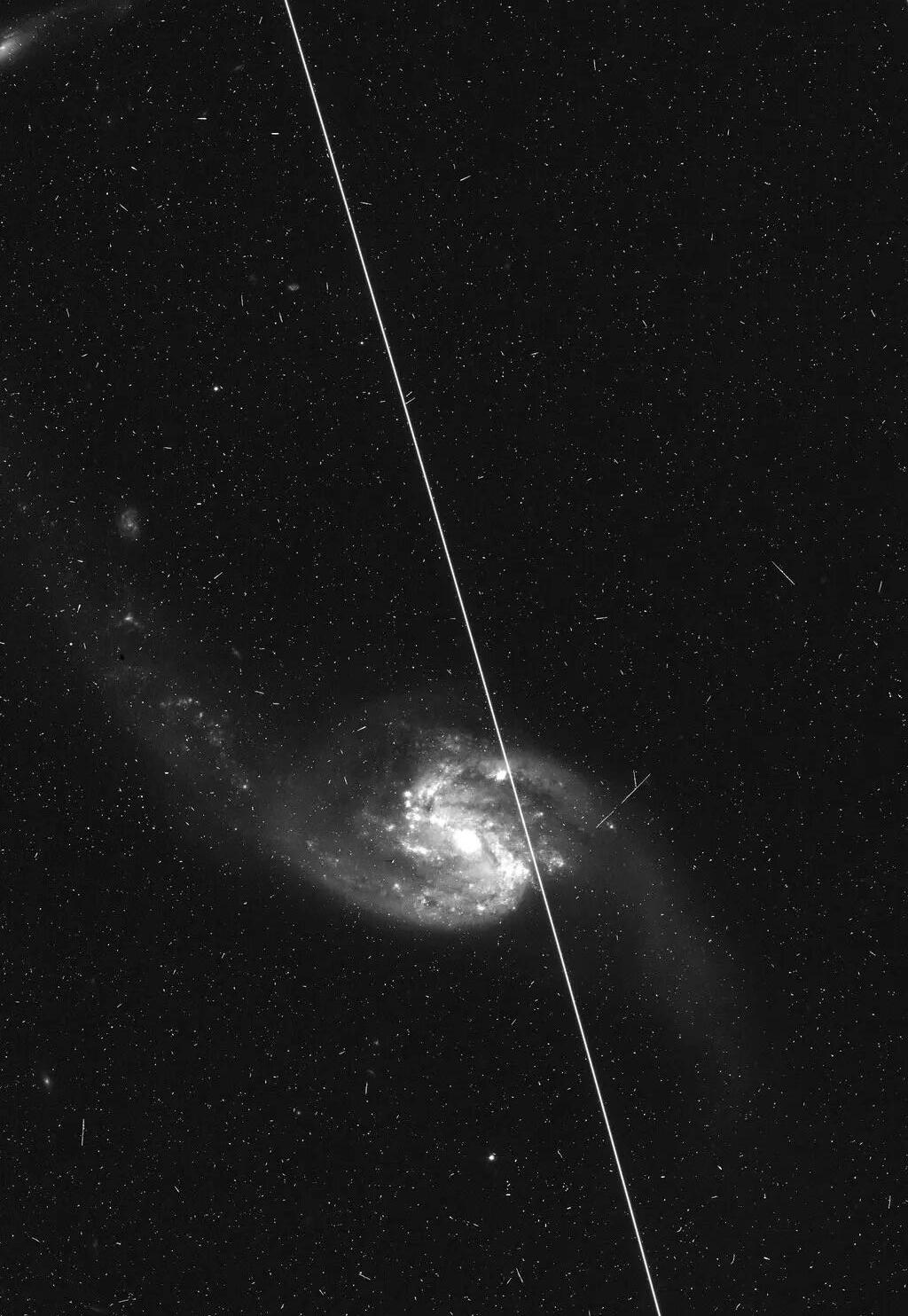
When satellites pass through a telescope’s field of view, they leave trails behind. Sometimes those trails aren’t bothersome or can be masked out; other times, such as in this Hubble image, that isn’t possible.
Credit: NASA / ESA / Kruk et al. / Nature 2023
• Established an observing network to allow the development of scientific papers on their impacts, and as a result:
• Conducted a pioneering study detecting for the first time unintended lowfrequency radio waves from the onboard electronics of 47 Starlink satellites, published in the Astronomy and Astrophysics journal.
• Organised an international observational campaign combining amateur and professional astronomers to follow AST SpaceMobile’s BlueWalker 3 satellite. The coordinated research, published in Nature, found that the peak brightness of the satellite reached an apparent magnitude of 0.4, making the new satellite one of the brightest objects in the night sky.
• Released SatChecker, which utilises the satellite ephemeris database to predict satellite transits through an image, factoring in celestial position, time of night, exposure length, and field of view.
• Made significant advancements toward a public Satellite Constellation Observation Repository (SCORE), which will enable observers to share their brightness data in a standardised format, and lays the groundwork for future publications.
• Created a GitHub repository to share code and tools under free licences, promoting transparency and collaboration within the scientific community.

These results demonstrate a continuing trend towards larger, brighter commercial satellites, which is of particular concern given the plans to launch many more in the coming years.
Assistant Prof. Siegfried Eggl, IAU CPS SatHub co-lead
BlueWalker 3 was launched into low Earth orbit on 10 September 2022 by AST SpaceMobile as a prototype for a planned constellation of over a hundred similar satellites intended for use in mobile communications. Observations made by members of the CPS shortly after launch showed the satellite was among the brightest objects in the sky with an apparent magnitude of 0.4. Scientists, including astronomers from the CPS, have been observing it ever since to understand its impact on astronomy.
In October 2023, they published a paper in Nature detailing the results of a 130-day observing campaign by professional and amateur astronomers, which showed how the satellite’s brightness changes over time.
They also observed the launch vehicle adapter attached to BlueWalker 3 decoupling from the satellite. This component reached magnitude 5.5, exceeding maximum brightness recommendations set out by the IAU to avoid the worst impacts of satellites on optical astronomy.
The satellite went unrecorded in public catalogues for four days. Such hardware is often left to drift for extended periods, and incomplete data on their orbits present further challenges for ground-based observatories trying to avoid them.
With companies intending to deploy more commercial satellites in the coming years, the results demonstrate the need for pre-launch impact assessments. Following the launch, AST SpaceMobile said BlueWalker 3 was a prototype and it was working to address the concerns of astronomers through several measures.
The Policy Hub aims to raise awareness of the impacts of satellites on astronomy and needed mitigations in space policy community, and coordinate policy activities conducted by national societies and observatories. In order to support national advocates in protecting dark and quiet skies, the Policy Hub aims to support the development of policy frameworks, commissioning studies and analyses on policy and regulatory issues, and identify emerging and future threats.
Policy Hub has structured its efforts into seven main work packages:
Production of a position document
• Overview of the problem and a summary of the position of the astronomy community, which can be updated periodically.
• Compilation and analysis of applicable space policy and regulations
• Examination of legal cases related to satellites and future regulatory developments
Space sustainability rating
• Facilitate the provision of technical and policy expertise to input into national and private labelling and rating schemes under development
• Seek input and co-ordinate the astronomy community over positions on the dark and quiet skies agenda
Policy advisory board
• Create a list of experts to support community position papers or to act as advisers
• Prepare responses, on behalf of the IAU, to public calls for comments on space policy and regulatory matters
• Identify emerging threats such as the imminent loss of protection of Cislunar radio-quiet zone, and the future novel space activities planned in LEO
Today the Policy Hub continues to actively engage with policymakers and analyse the evolution of space policy and regulation on dark and quiet skies. The hub aims to continue playing a leading role for the astronomy community in all relevant forums at the United Nations and globally, in particular within COPUOS.
With over 150 members, the Policy Hub welcomes participation from policy and legal experts in all the areas described above, and encourages collaborative efforts to address these critical challenges.
• Led the development of the CPS position paper (see p29), outlining the centre’s stance on the protection of dark and quiet skies
• Developed and consolidated a set of recommendations for minimum specifications for satellites to ensure minimal optical and radio impacts.
• Secured support from G7 science ministers for continued discussions on the impact of large satellite constellations on astronomy, in an official communiqué adopted ahead of the G7 Summit in Hiroshima, Japan in 2023 (see opposite page).
• Undertook a comparative analysis and synthesis of the current state of national policies, international law, and other multinational instruments related to space sustainability.
• Contributed to the ongoing development of the Space Sustainability Rating (SSR), a scoring system for satellite operators that evaluates decisions made during the design, operation, and end-oflife phases of a space mission, to introduce a dark and quiet skies module.
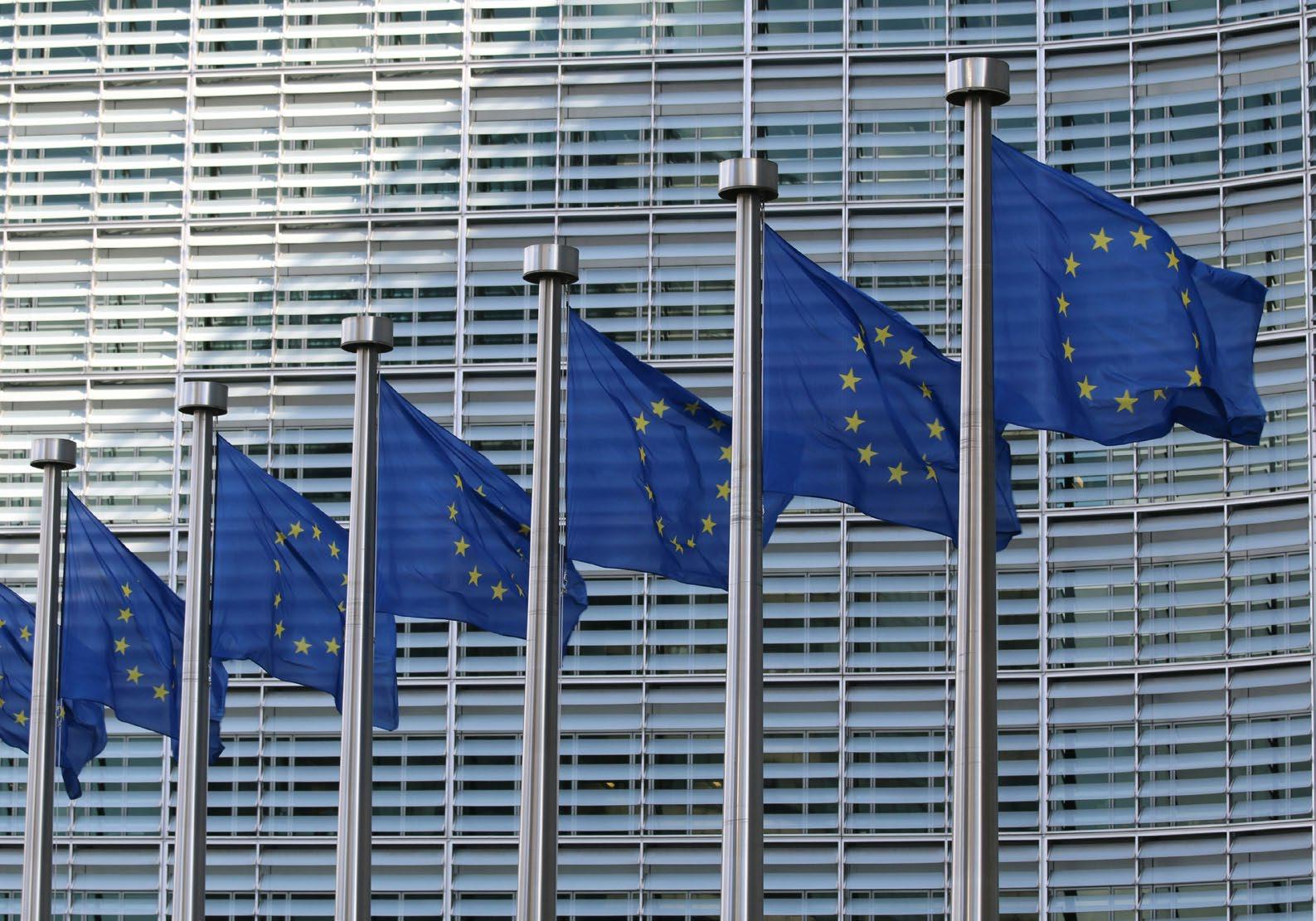
In November 2023, the European Union opened a public consultation to seek input on the development of a European level “space law” (EUSL). The EUSL envisages setting common EU rules addressing the safety, resilience and sustainability of space activities and operations. The intention is to avoid and remove fragmentation and barriers caused by the heterogeneity or lack of national space legislations, while ensuring the competitiveness of the European space sector in an international trade context. The EUSL, as a coherent legal framework, would also bring legal certainty for space market operators and will support the competitiveness of the European industry.
Given its significance to the future of space policy in Europe and the impact on national space industry, the IAU CPS Policy Hub, in cooperation with the European Astronomical Society (EAS) and the EU Committee on Radio Astronomy Frequencies (CRAF) prepared a coordinated and aligned submission. Drawing from a consolidated set of recommendations developed in previous work, the Policy Hub prepared an analysis of the EU public consultation and drafted template responses, which the EAS and CRAF could adapt and enhance with futher details. The EAS further promulgated the template through its national partner societies, leading to 12 separate responses from European national societies and observatories.
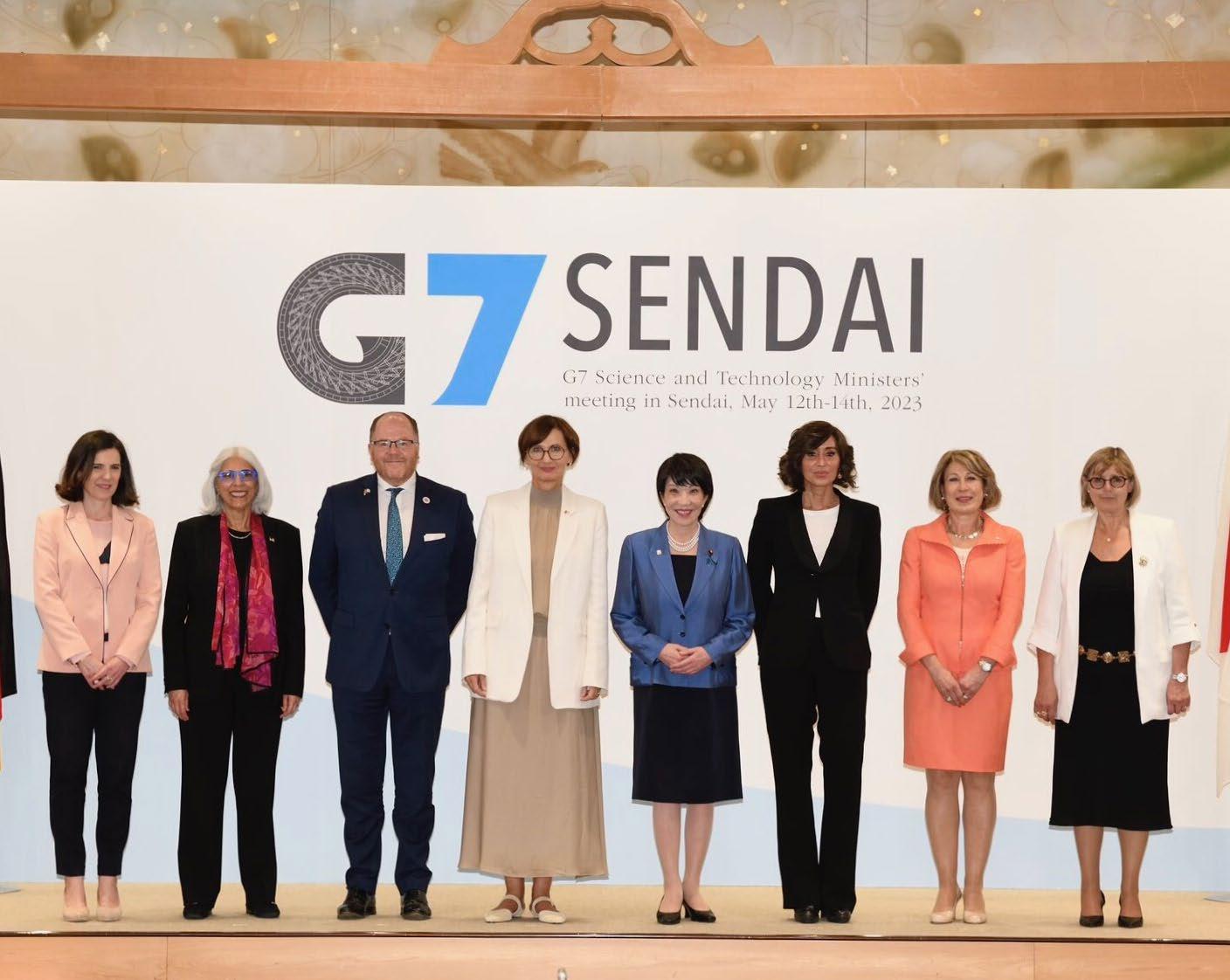
We recognize the importance of continued discussion, in the UN COPUOS and International Telecommunications Union (ITU) frameworks, as well as with the International Astronomical Union (IAU) on the impact of large constellations of satellites on astronomy for the protection of the dark and quiet skies.
G7 Science and Technology Ministers Communique

The Industry and Technology (I&T) Hub focuses on fostering collaboration between the broader astronomical community and satellite operators. The hub encourages the creation and implementation of best practices around satellite constellations and promotes cooperation between competing companies to share technologies and strategies that mitigate the disruptive effects of satellite light and noise. This collaboration is facilitated through the development of shared forums that bring together all stakeholders.
To structure its mission, the I&T Hub has three key objectives:
• Carry out outreach activities alongside satellite constellation operators, manufacturers and other stakeholders to create participation and collaboration.
• Develop resources to inform and educate satellite operators on astronomy’s concerns and share recommendations and current best practices.
• Foster the sharing of mitigation techniques and their efficacy between operators as well as encourage development and innovation around new approaches and tools including materials, testing facilities, simulation software etc.
In addition to serving as an intermediary between the industry and professional astronomers, the I&T Hub aims to educate constellation operators, consolidate best practices, and highlight mitigation techniques.
Over time, the I&T Hub has built a reputation as a trusted venue with the goal of encouraging intra-industry collaboration on mitigation techniques. The hub is now looking to expand its industry engagement with plans to engage trade associations and satellite manufacturers, as well as encouraging more constellation operator proponents to participate in the I&T Hub and commit to mitigation activity. The I&T Hub welcomes further participation from industry in all the areas described above.
• Compiled an essential reading list for industry as an introduction to the topic, including articles, reports, and papers covering potential impacts and mitigations, commercial drivers, and effects on Indigenous communities, among other topics.
• Developed an Astronomy101 programme designed to give satellite constellation operators an insight into the astronomy sector, its priorities, and concerns;
• Created a Technical Advisors Group comprising 14 industry members, including operators of deployed and planned LEO constellations, as well as manufacturers of spacecraft and key subsystems. The group hosts regular meetings to discuss mitigation technologies, predictive test and assessment tools, and enhance understanding of the astronomy community. Notably, SpaceX has developed a dielectric film that reduces solar reflection from satellites and has offered it to other operators at cost;
• Launched an Astronomy Guides programme which partners astronomers with industry to facilitate dialogue between the two communities, allowing for a more detailed understanding of the operator’s processes and more effective advice.

“We are deeply committed to protecting all-human spaceflight and making sure that space is safe, sustainable and accessible and along with that to do our part in keeping the skies as dark and quiet as possible.
Dave Goldstein, Principal Engineer, SpaceX

Ancient petroglyph located within Bears Ears National Monument in Utah, USA. The area was inhabited as early as 13,000 years ago, and some of the petroglyphs have been dated to between 3,000 and 6,000 years old.
The CPS Community Engagement (CE) Hub aims to establish a fairminded forum for the conscious and respectful discussion of nearEarth space use and its effects on all stakeholders and communities. The CE Hub seeks to engage stakeholders, solicit their opinions, and create engagement activities and content to help the general public understand the issues caused by satellite constellations. Ultimately, the goal is to cultivate a community passionate about protecting dark and quiet skies..
These voices constitute our primary audiences and include the following:
• Professional astronomers
• Amateur astronomers
• Astrotourism operators
• Astrophotographers
• Cultural and religious users of the night sky
• Casual stargazers
• General public
The CE Hub aims to serve as a conduit for all these voices to engage in respectful discussions about dark and quiet skies. To achieve this, the CE Hub has established four key objectives:
The Hub is committed to the values of community, diversity, inclusion, empathy, respect, and transparency. Throughout the history of the private space economy, many voices have gone unheard and have not received fair consideration due to asymmetries in economic, social, and political power.
• Create a venue in which all stakeholders may be heard and feel safe expressing their opinions and views.
• Manage the CE Hub in a way that fosters respectful dialogue among participants to prompt the understanding of different and potentially opposing viewpoints.
• Over time, amass a set of stakeholder opinions as primary sources that we compare critically to find common themes.
• Use the materials and the conclusions we draw from them, to inform the activities of the other CPS hubs and our communications with the public on relevant issues.
Over time, the hub aims to create and develop a range of educational materials to effectively communicate the importance of dark and quiet skies such that stakeholders can come to their own informed opinions. As part of its initiatives, the CE Hub will also offer a programme of semipublic, interactive, virtual events throughout the year. This increase in community engagement will be accompanied by improved mechanisms for identifying potential stakeholders and a more clearly defined method for soliciting stakeholder participation and feedback.
The CE Hub is actively recruiting participants and fostering engagement, focusing on the communities highlighted above. It welcomes support and involvement from all interested parties around our key objectives.
This video training series aims to promote factual understanding of large satellite constellations in order to help participants come to reasoned and informed opinions about this important social and technological issue. The 8 learning modules cover satellite design, environmental impacts, effects on optical and radio astronomy, cultural impacts, the current policy climate, and potential satellite mitigations.
• Invited several knowledge holders and Elders from First Nation and Indigenous communities in North America to share their perspectives on satellite constellations with the professional astronomy community, industry, and diplomats, during the IAU symposium on satellite constellations.
• Published a Foundational Report collecting together the history of events that led up to the establishment of CPS, the aims of CE Hub, and its initial plans and activities.
• Organised a “CE Day” at IAU Symposium 385 (“Astronomy and Satellite Constellations: Pathways Forward”) in October 2023.
• Developed the eight-video curriculum SatCons 101 that covers key topics surrounding satellite constellations as a general introduction to the issue.

The CPS and its members engage with a number of international bodies, either directly or through organisations which are themselves represented on these bodies.
The Committee on the Peaceful Uses of Outer Space (COPUOS) was established by the United Nations General Assembly in 1959 to oversee the exploration and use of space for the benefit of all humanity. The Committee’s mandate includes reviewing international cooperation in the peaceful uses of outer space, studying space-related activities that the UN could undertake, encouraging space research programmes, and addressing legal issues arising from space exploration. With 102 member countries and 51 observer organisations, COPUOS is one of the largest committees within the UN. Several astronomy organisations are represented on the committee as observers, including the European Space Agency, the European Southern Observatory (ESO), the SKAO, the IAU, and the European Astronomical Society (EAS).
Following growing support for protecting dark and quiet skies within COPUOS in 2022 and 2023, the delegations of Chile and Spain initiated a Group of Friends of the Dark and Quiet Sky for Science and Society in October 2023, for which the CPS provides the technical secretariat, facilitating its meetings, producing documents, and supporting the group’s events and engagement activities. The Group of Friends’ primary objective is to promote global awareness of the impact of launched and planned satellite constellations on astronomy and support development of mitigation tools that are affordable, accessible and effective.
In 2024 and after intense discussions, COPUOS agreed to include an item on its agenda for the next five years with the title “Dark and Quiet Skies, astronomy and large constellations: addressing emerging issues and challenges”. The proposal championed by Chile and Spain received widespread support and was co-signed by several delegations.

The CPS acts as the secretariat for the Group of Friends, providing support to its activities like this panel discussion at COPUOS to promote awareness of the impact of satellite constellations on astronomy.
Panel discussion
Preserving Dark and Quiet SkiesResponsible practices for science and development within the framework of APEP-Space

Co-organised by the Permanent Mission of Chile and the Permanent Mission of Spain
Vienna International Centre Room M3, June 20th, 5pm


The International Telecommunication Union (ITU) is the United Nations’ specialised agency for information and communication technologies. Established in 1865, it is the oldest UN agency. The ITU comprises 193 member countries and over 1,000 organisations. Its primary role is to allocate global radio spectrum and satellite orbits and to develop technical standards that ensure seamless connectivity of networks and technologies worldwide.
Satellite operators and radio astronomers have long been active at the ITU as a means to discuss radio frequency allocations and operational rules. Radio astronomy has been represented by host governments and through bodies like CRAF, the European Science Foundation’s Committee on Radio Astronomy Frequencies, and similar groups for other regions who collectively have been advocating for improved protection of radio astronomy for years. This has resulted in the past in the allocation of very specific, narrow bands of the electromagnetic spectrum for radio astronomy. Similarly, satellite communications services have been allocated specific frequency bands for their delivery of services and operation of spacecraft; however new applications and larger deployments
of satellite constellations have put increasing pressure on spectrum sharing approaches for satellite services and radio astronomy to co-exist without harmful interference.
In November 2023, the European and African groups within the ITU formally proposed agenda items that proposed to look at the risks of satellite constellation interference on the protection of radio quiet zones and radio telescopes. The proposals built upon major efforts from both the CPS and some of its members, in particular CRAF, the South African Radio Astronomy Observatory (SARAO), and the SKAO.
Intense negotiations took place at the 2024 World Radio Conference in Dubai before the final proposal was endorsed by the 193 countries represented at the ITU. As a result, telecommunication agencies, the radio astronomy community and satellite industry are working together to better understand the impact of large satellite constellations on radio astronomy sites, especially in radio quiet zones. Their goal is to identify better regulatory protection for the frequency bands that are allocated to radio astronomy, and to study the characteristics and possible international protection for radio quiet zones.
Radio quiet zones are geographic areas created by governments through legislation to protect sensitive radio telescopes from ground-based interference – such as that emitted by mobile phones, microwaves, or car radars – so that they can receive the much fainter signals emitted by natural phenomena in the Universe. While such areas prevent a lot of harmful emissions from being emitted near the telescopes, they are not currently recognised internationally and therefore have no influence over satellite operations.
“
The positive developments at the ITU show that astronomy has garnered a significant profile and attention in international bodies like the UN. The work starting now within the ITU to study the impact of satellite constellations on radio astronomy will be key to obtain better protections.
Federico Di Vruno, SKAO Spectrum Manager and CPS Co-Director
Every four years, the radio regulations, the international treaty governing the use of the radio spectrum, are updated in a global negotiation that sees all 193 member countries of the ITU agree to a new version of the regulations.
The 2023 World Radiocommunication Conference took place in Dubai, UAE.
Credit: ITU/D. Woldu
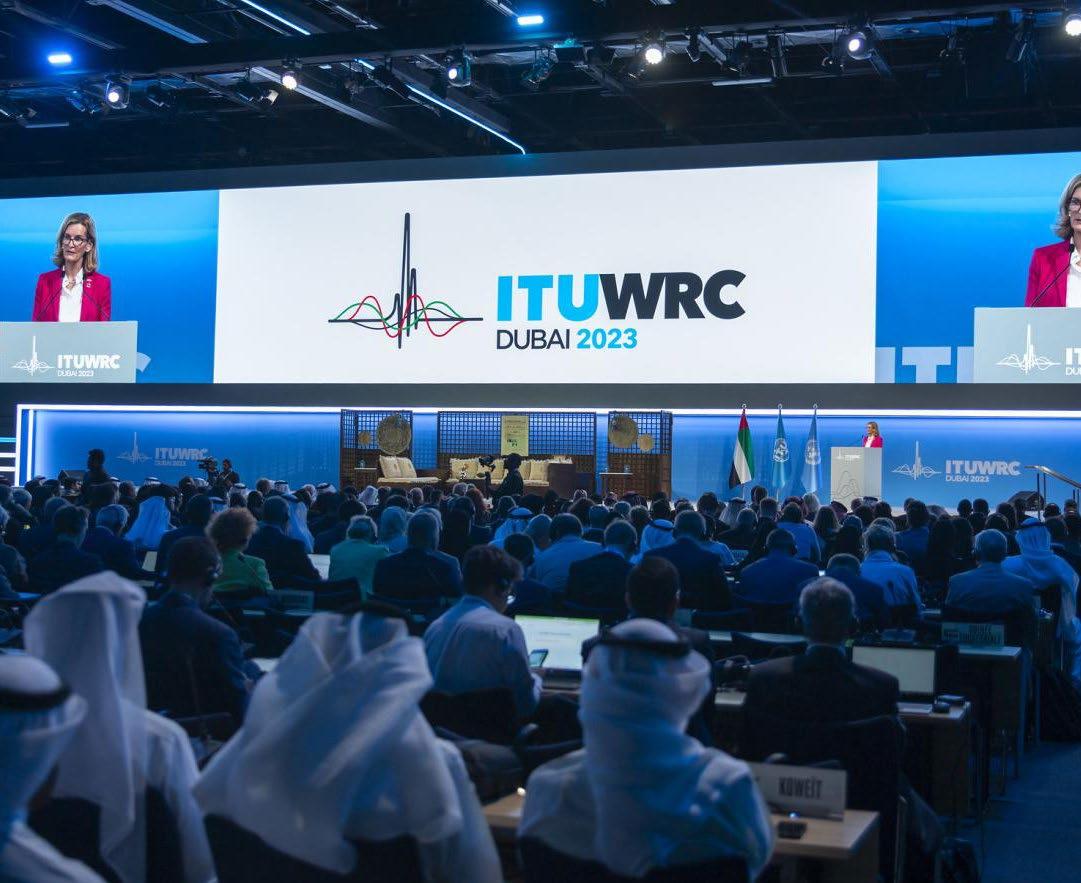


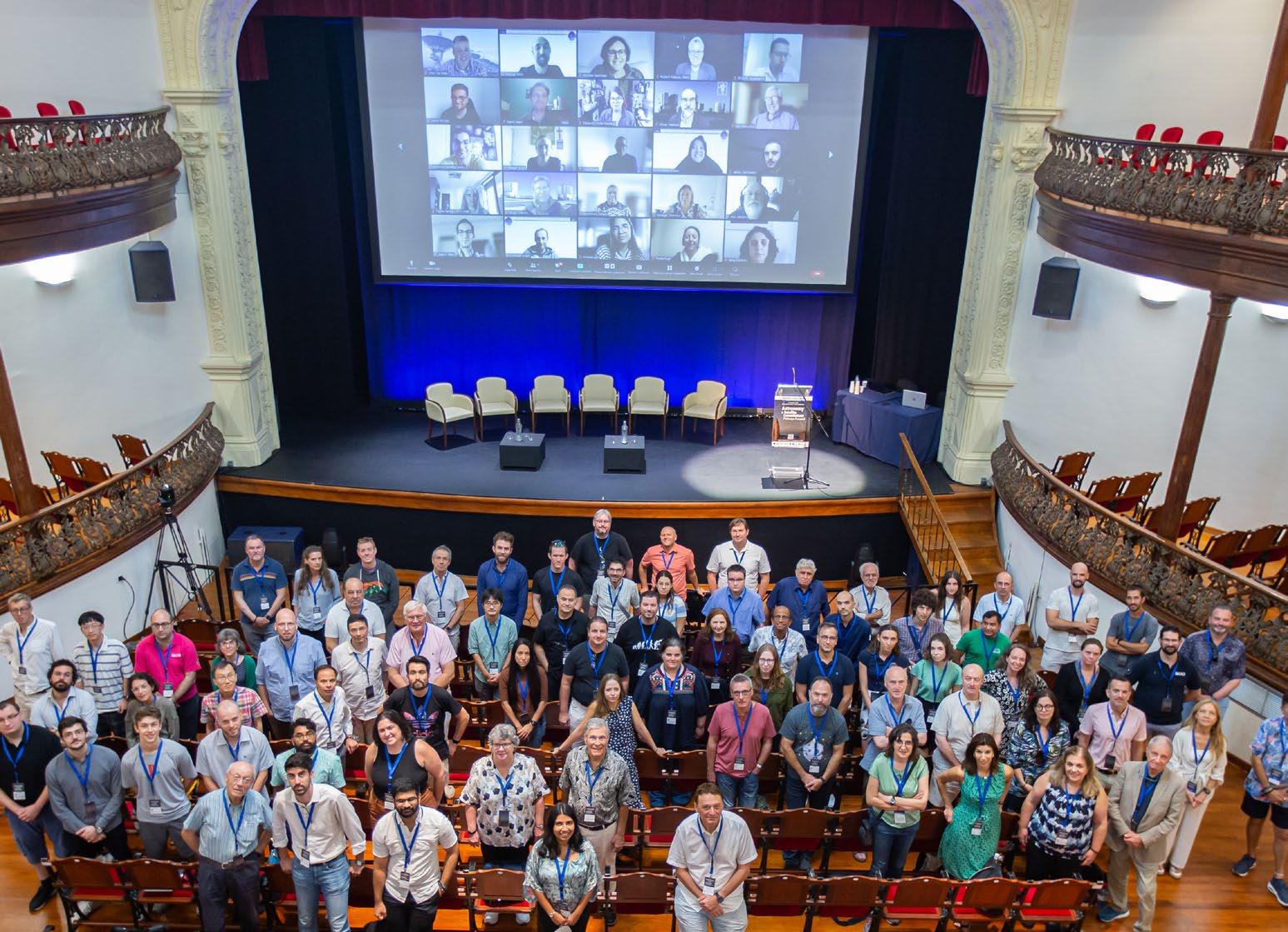
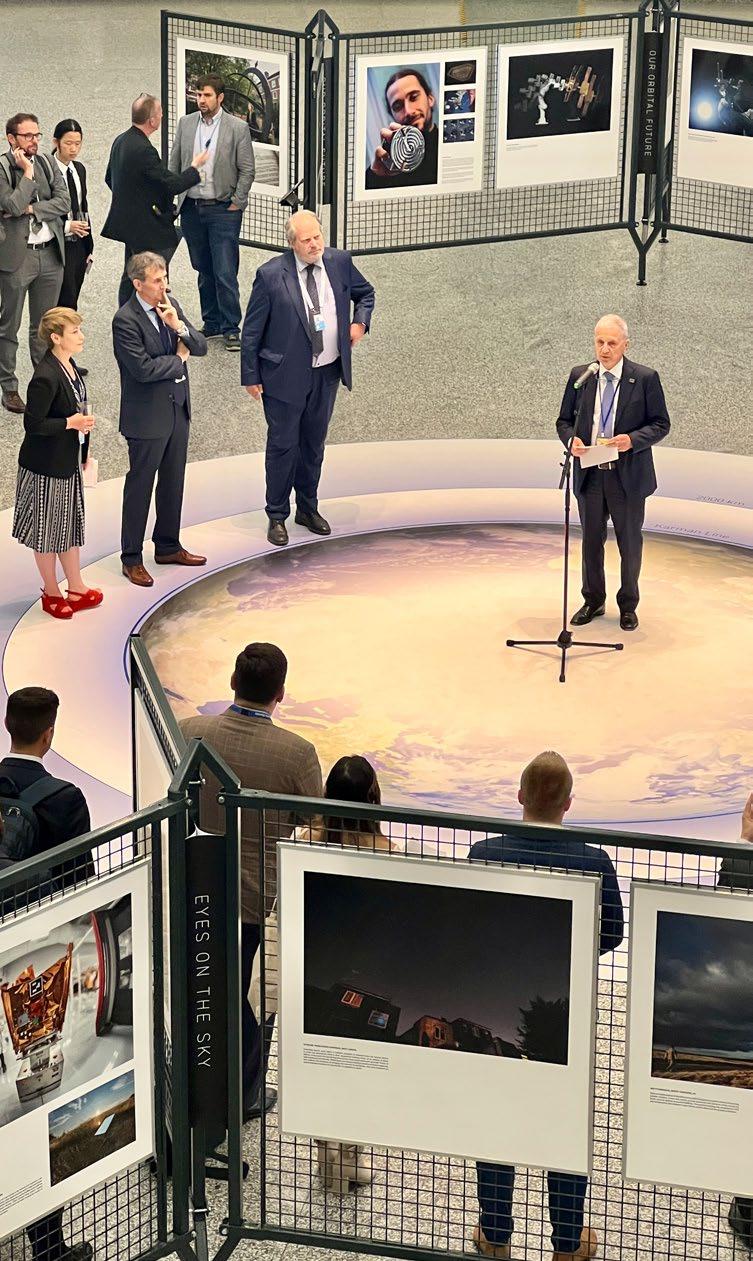

There are several ways individuals and organisations can get involved in supporting the work of the CPS.
The CPS serves as a central hub for the efforts of numerous academics and industry professionals dedicated to preserving dark and quiet skies, as well as organisations wanting to support these efforts. By joining the CPS, you contribute to this shared goal. Membership in the CPS is completely free for both individual and organisational members.
The CPS is particularly looking for more professional astronomers and policy experts to contribute to its work; satellite operators wanting to engage on the topic of dark and quiet skies; as well as experienced amateur astronomers willing to help with observations.
Individual membership is divided into two groups: contributing members and affiliated members. Contributing members commit to specific core activities for the centre and agree to deliver contributions according to the schedule and requirements of the work plan. Affiliated members, on the other hand, agree to participate in the centre’s activities without committing specific resources and deliverables.
Members must fill in a membership form and adhere to the CPS code of conduct. Their application is then reviewed before being accepted.
To join the CPS, head to our website and fill in the form.
The CPS also accepts organisations as contributing or affiliated members through the completion of ad-hoc agreements. The CPS will ask organisations interested in contributing to specify what kind of support they can provide.
The CPS is eager to collaborate directly with the satellite manufacturing and operating industry to enhance mitigation techniques across the sector. By joining CPS, industry members gain access to a range of valuable resources through the Innovation and Technology Hub. These include regular updates, technical briefings, informational exchange platforms, operator recommendations, and best practices. Additionally, members can utilise the SatHub’s Consolidated Observation Network, which provides critical assessments of satellite visibility. Several leading companies have already benefited from these resources.
The CPS benefits from seed-funding from the IAU to support core expenses, and in-kind resources provided by its host institutions the SKAO and NOIRLab to manage the Centre.
The rest of the Centre’s activities, including all of the hubs’ work, are conducted on a volunteer basis. In the face of the scale of the challenge represented by satellite constellations, the CPS is looking to increase its ability to support the protection of dark and quiet skies through fundraising efforts.
This funding may come from institutions, companies, or foundations, and can take the form of financial contributions or in-kind contributions for the following activities.
Funding is needed to support full-time equivalent positions for software, engineering, and observing projects; enhanced interactions with industry and policy makers, translation for regional impact, as well as interns, short-term project leads, and the development of training materials.
Funding is also needed to support expanded operations within data systems, software packages and observing run support such as rapidly updated ephemerides and avoidance software, as well as support for research on thresholds for harm to astronomical data quality, motivating technical requirements at an engineering-specific level.
The CPS is also keen to host prizes encouraging innovation within satellite constellation operators.
Funding is necessary to allow increased community engagement through support for international meeting attendance, the hosting of workshops, the development and publication of reports, articles and other engagement content such as videos translated in various languages.
To discuss funding options, please get in touch with the CPS Management team at mt@cps.iau.org
“
It takes a community to solve this challenge, trying to reduce the impact of satellite constellations on astronomy.
Connie Walker NOIRLab Head of Site Protection and CPS Co-Director
Many astronomers are already active in public engagement. The CPS encourages professional astronomers, teachers, educators, and amateur astronomers working within formal education, science centres and planetariums, and other astronomy enthusiasts, to raise awareness of the impact of satellite constellations on astronomy with their audiences.
To support those efforts, the CPS is providing a set of resources, including videos, graphs, presentations, key messages, etc. for anyone to use freely which can be found on the CPS website.
Citizens already engage with their representatives on a number of issues that affect their communities, whether that’d be the environment, or light pollution. The CPS welcomes all support, and indeed welcomes citizens contacting their locally elected representatives to raise awareness of the impact of satellite constellations on astronomy.
You may want to focus your attention on the impact of satellites on any nearby observatories, or simply on the impact of satellites on your enjoyment of the night sky.

A long-exposure image of the Orion Nebula with a total exposure time of 208 minutes showing satellite trails in mid-December 2019.
Credit: A. H. Abolfath/NOIRLab/NSF/AURA
• The CPS encourages States and the international community to make every practical effort to prevent the catastrophic loss of high quality observations of the dark and quiet sky through establishing regulations and terms of licensing that require operators to exercise due regard for global visibility and to mitigate the impacts on observational astronomy through:
• A visual magnitude limit of 7th magnitude, dependent on altitude, ensuring the invisibility of LEO satellites to the naked eye and mitigating some data loss in observations, initially on the basis of best efforts until technology is mature;
• Addressing optical visibility over the full mission lifetime, including orbit raise and de-orbit;
• Implementing and policing existing international regulation and strengthening the protection of radio astronomy from satellite constellations in radio bands allocated to radio astronomy by developing appropriate measures in the ITU Radio Regulations and on a national basis;
• Recognising that modern radio astronomy requires broadband spectrum protection beyond the allocated narrow frequency bands in the ITU Radio Regulations, and hence that national or international regulatory protection also from satellite constellations is required to maintain the efficiency of radio quiet zones around telescopes;
• Introducing a global electromagnetic compatibility (EMC) standard for unintended radiation from the electronics of satellites, which recognises the protection of radio astronomy;
• Proper implementation of the relevant tenets of the OST and its elaborating conventions and the ITU Radio Regulations;
• Consideration of the applicability of the environmental legal framework to outer space and activities conducted therein, for the purpose of protecting astronomy and mitigating impacts on Earth’s ecological systems;
• Space sustainability laws limiting the generation of space debris and facilitating a fast deorbiting strategy, with the purpose of limiting the global increase in diffuse sky background to no more than 10% artificial contribution;
• The CPS recommends that government authorities responsible for licensing the launch and operation of satellites require an impact assessment and base their subsequent licensing decision on criteria covering but not limited to:
• An analysis of brightness taking into account the quantitative limits defined in this document, based on well-measured materials reflection properties;
• An analysis of the cumulative radio emissions and unintentional electronic
noise, including strategies to minimise the impact on radio-quiet zones and telescope sites;
• Requirements for operational data sharing to mitigate impacts on astronomy; and
• Consideration of the balance between mission objectives, orbital sustainability, and interference on other space activities.
• The CPS encourages States to take a wholeof-government approach to supporting and encouraging development of mitigations of the impact on astronomy:
• Support astronomical observatories to develop, test, and operate required mitigation techniques to minimise the impact of large satellite constellations;
• Implement incentive measures for industry to develop and implement technical and operational techniques to protect astronomy from the negative impacts of large satellite constellations, including predictive tools and test labs to assess brightness using designs or prototype satellites, and basic research on lessreflective alternate materials, as well as the reduction of radio radiation in unwanted directions and at unwanted frequencies.
• The CPS encourages the satellite industry to:
• Continue the collaboration with astronomy to explore the effective co-existence of their services and astronomy;
• Share mitigation experiments and resources within the satellite industry community to spur the development of affordable, accessible and effective mitigation options;
• Consider mitigating the impacts on astronomy as an essential component of their long-term sustainability and ESG approaches.
The full position paper is available on the CPS website’s Resources page

The Earth’s shadow, as delineated by sunlight reflecting off Starlink satellites passing overhead, captured in Utah on 6–7 May, 2024.

